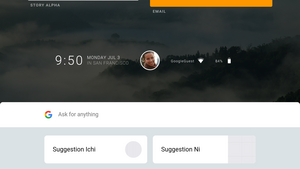Google Fuchsia
 Fuchsia操作系统标志 | |
 Armadillo用户外壳的截图,Fuchsia的一部分 | |
| 开发者 | |
|---|---|
| 编程语言 | 多种:C、C++、Rust、Go、Python、Dart |
| 作業系統家族 | Zircon |
| 運作狀態 | 当前 |
| 源码模式 | 开放源代码 |
| 首次发布 | 2016年8月15日 |
| 当前版本 |
|
| 支持的语言 | 英语 |
| 支援平台 | ARM64、X86-64 |
| 内核类别 | 微內核 基于能力 实时操作系统 |
| 许可证 | 多种:BSD 3 clause、MIT和Apache 2.0 |
| 官方網站 | fuchsia |
| 仓库 | |
Fuchsia是Google开发的操作系统[2],與基于Linux内核的ChromeOS和Android等不同,Fuchsia基于新的名为Zircon的微内核[3],受Little Kernel启发[4],用于嵌入式系统,主要使用C语言和C++编写[5]。Fuchsia的设计目标之一是可运行在众多的设备上,包括移动电话和个人电脑。[6]經過多年的發展,它的正式產品發布於第一代Google Nest Hub上,取代了其原來基於Linux的Cast OS。

作为免费和开源软件分发,采用三句版BSD,MIT和Apache 2.0软件许可证。
历史
[编辑]2016年8月,媒体报道了发布于GitHub上的神秘源码,显示Google正在开发一个名为“Fuchsia”(「品紅色」的英文)的新操作系统,虽然官方没有正式公布,其源码检查显示其能够跨平台运行,包括“汽车的娱乐媒体系统和嵌入式设备,如红绿灯、数码手表、智能手机、平板电脑与个人电脑”。[7][8]
2017年5月,Ars Technica编写了关于Fuchsia的新用户界面的文章,从8月首次披露时的命令行界面上升级,以及开发人员表示“此项目不是玩具项目,不是20%时间项目,不是我们不再关心的死去的项目的垃圾场”,多家媒体写到“Fuchsia项目”和Android似乎有密切联系,有人猜测Fuchsia可能是“重做”[9]或替换Android[10][11]以在某种程度上修复该平台上的问题。
2018年1月3日,Google允许开发者以Google Pixelbook为目标设备,下载Fuchsia OS进行开发与测试[13][14][15]。
2018年4月,Fuchsia的原始碼出現在AOSP的ART當中,疑似是AOSP已經開始將ART移植至Fuchsia上,但原始碼仍處於被註釋處理的狀態。[16]
2019年6月28日,Fuchsia OS的开发者网站Fuchsia.dev上线。[17]
2020年12月8日,首度在Google Open Source 部落格亮相,籲開發者來做出貢獻。[18]
2021年5月,Google員工證實,它首次在消費者市場部署了Fuchsia,這是對第一代Google Nest Hub的軟體更新,該軟體取代了基於Chromecast的軟體,不過此更新不包含面向使用者的更改。[19][20] 對預覽版設備進行第一波更新後,該更新於2021年8月推出至所有Nest Hub設備。[21]
特性
[编辑]Fuchsia的用户界面与应用使用“Flutter”开发。Flutter是一个能为Fuchsia、Android和iOS进行跨平台开发的开发框架,基于Dart创建应用,能让应用达到120FPS的高性能。
得益于Flutter提供的跨平台能力,用户可以在Android设备上安装一部分Fuchsia。Ars Technica注意到尽管用户可以测试Fuchsia,但是并不“可用”。他们还补充,尽管能看出Fuchsia与Android的界面有很多相似之处,比如应用屏幕、设置彩蛋和同时浏览多个应用的分屏功能等,但“全都只是占据位置而不可用”[22]。
Ars Technica注意到Fuchsia的很多部分都能工作,尤其是硬件支持[23]。
参考文献
[编辑]- ^ https://fuchsia.dev/whats-new/release-notes/f20.
- ^ Prince, Rob.
- ^ Lopez, Napier (13 August 2016).
- ^ magenta/mg_and_lk.md at 1e009f296dc397a2a0ba3a9fe364a662a57a3ace · fuchsia-mirror/magenta. GitHub. [26 Oct 2016].[永久失效連結]
- ^ "Google Is Building A New Operating System From Scratch: 'Fuschia'". 2016-08-15.
- ^ Fingas, Jon.
- ^ Etherington, Darrell. Google’s mysterious new Fuchsia operating system could run on almost anything. TechCrunch. AOL. August 15, 2016 [October 5, 2016]. (原始内容存档于2019-06-05).
- ^ Fingas, Jon. Google's Fuchsia operating system runs on virtually anything. Engadget. AOL. August 13, 2016 [October 5, 2016]. (原始内容存档于2019-02-10).
- ^ Fingas, Jon. Google's mysterious Fuchsia OS looks like an Android re-do. Engadget. AOL. May 8, 2017 [May 9, 2017]. (原始内容存档于2019-02-11).
- ^ Gartenberg, Chaim. Google’s mysterious new Fuchsia OS has a UI now. The Verge. Vox Media. May 8, 2017 [May 9, 2017]. (原始内容存档于2019-06-05).
- ^ Davenport, Corbin. Google's "Fuchsia" operating system is taking shape with a new design. Android Police. May 8, 2017 [May 9, 2017]. (原始内容存档于2019-10-31).
- ^ Add Fuchsia OS support. GitHub PR for Swift. 2017-11-15 [2018-02-02]. (原始内容存档于2019-05-01).
- ^ Preparing to install Fuchsia on Pixelbook[永久失效連結].GitHub.[2018-01-03].
- ^ Putting Fuchsia on a Device[永久失效連結].GitHub.[2018-01-03].
- ^ Google允许以自家Pixelbook测试Fuchsia OS (页面存档备份,存于互联网档案馆).科技新報.[2018-01-03].
- ^ 谷歌 Fuchsia 源码现身 AOSP,支持 ART 运行环境 - 开源中国社区. www.oschina.net. [2018-05-11]. (原始内容存档于2019-06-09) (中文(中国大陆)).
- ^ Bradshaw, Kyle. Fuchsia.dev: Google launches official site about Fuchsia OS. 9to5Google. 2019-06-28 [2019-06-29]. (原始内容存档于2020-11-20) (美国英语).
- ^ Expanding Fuchsia's open source model. 2020-12-08 [2020-12-10]. (原始内容存档于2021-01-15) (美国英语).
- ^ Amadeo, Ron. Google launches its third major operating system, Fuchsia. Ars Technica. 2021-05-25 [2022-07-17]. (原始内容存档于2021-08-03) (美国英语).
- ^ Bradshaw, Kyle. Google is releasing Fuchsia OS, starting w/ 1st-gen Nest Hub. 9to5Google. 2021-05-25 [2022-07-17]. (原始内容存档于2021-07-16) (美国英语).
- ^ Byford, Sam. Google’s Fuchsia OS is rolling out to every first-gen Nest Hub. The Verge. 2021-08-18 [2022-07-17]. (原始内容存档于2022-05-13) (美国英语).
- ^ Amadeo, Ron. Google’s “Fuchsia” smartphone OS dumps Linux, has a wild new UI. Ars Technica. Condé Nast. 2017-05-08 [2018-04-04]. (原始内容存档于2019-09-26).
- ^ Amadeo, Ron. Google’s Fuchsia OS on the Pixelbook: It works! It actually works!. Ars Technica. Condé Nast. 2018-01-08 [2018-04-04]. (原始内容存档于2019-12-17).
Right now, Google's built-from-scratch kernel and operating system will actually boot on the Pixelbook, and some things even work. The touchscreen, trackpad, and keyboard work and so do the USB ports. You can even plug in a mouse and get a second mouse cursor.
外部链接
[编辑]- Fuchsia OS开发者网站 (页面存档备份,存于互联网档案馆)
- GitHub上的Fuchsia-mirror (页面存档备份,存于互联网档案馆)
- Fuchsia的源代码库(页面存档备份,存于互联网档案馆)
- (非官方)Google Fuchsia Wiki(页面存档备份,存于互联网档案馆)
- Fuchsia OS 中文社区 (页面存档备份,存于互联网档案馆)

